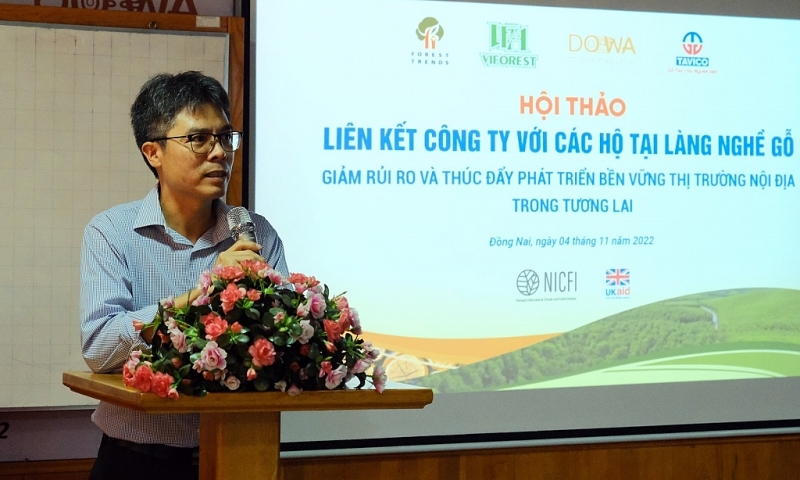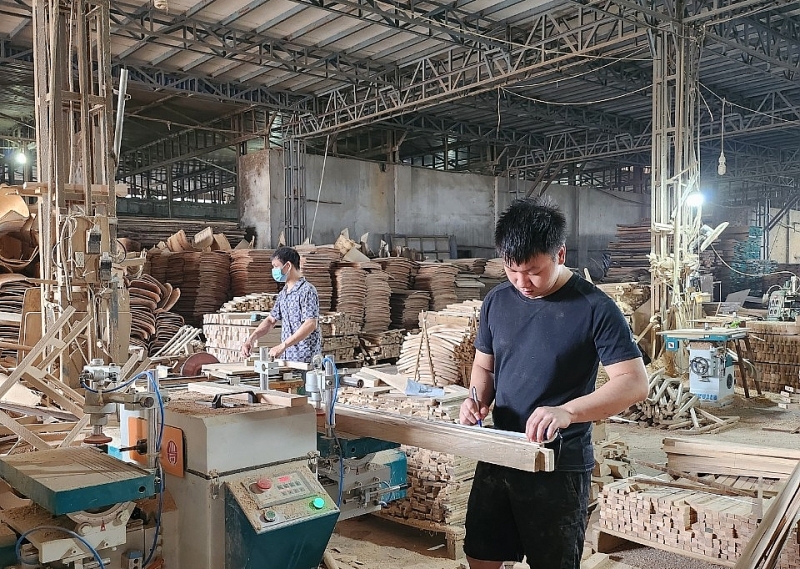 |
| Mr. To Xuan Phuc, representative of Forest Trends, spoke at the workshop |
Speaking at the Workshop “Linking companies with households in woodcraft villages: Reducing risks and promoting sustainable development of the domestic market” organized by the Vietnam Timber and Forest Products Association, Forest Trends, and the Association Dong Nai Wood Processing and Tan Vinh Cuu Joint Stock Company (Tavico) held on November 4, Mr. Do Xuan Lap, Chairman of the Vietnam Wood and Forest Products Association said each year, Vietnam imports about 4-5 million m3 of raw wood, of which 30-40% is risky wood.
This has been having negative impacts on Vietnam’s wood industry, especially in the export stage.
“The US 301 investigation into Vietnam’s timber exploitation and trade at the end of 2020 is a good example of this negative impact,” Mr. Lap said.
The Vietnamese government is strongly committed to removing illegal timber from the supply chain, both for export and domestic consumption.
“Eliminating the amount of imported risky timber requires households in craft villages to switch to low-risk types, including locally grown timber or planks. Therefore, not only are craft villages in charge but also the responsibility of society, management agencies and the whole wood business community take responsibilities,” said Mr. Lap.
According to Mr. To Xuan Phuc, a representative of Forest Trends, there are currently more than 300 craft villages producing and processing wood, mainly concentrated in the Northern Delta, employing tens of thousands of households in the region.
The source of input wood for craft villages is very diverse thanks to long-standing “hereditary” tradition. In which, the product group is made from planted forest wood, and plywood for the low segment of the market (cheap price, simple design).
The group of products made from low-risk imported wood is the middle segment of the market (average price, bright products, and modern designs). Finally, the group of products made from imported wood is natural and risky wood.
“Besides a number of craft villages struggling in the transformation process to meet the needs and tastes of the market, there are also positive signals when many craft villages such as Lien Ha, Huu Bang, etc. have made great efforts to link up with businesses to be able to supply legal sources of wood materials,” said Mr. Phuc.
Mr. Nguyen Van Truong, a representative of Thuy Lam craft village (Hung Yen) said that households working in Thuy Lam wood processing village used to have a hard time due to unsecured imported wood sources.
For example, Laotian wood had been selected to process products for the markets due to its large and eye-catching shape. However, shrinkage is not taken into account leading to buckling in the surface. As a result, Thuy Lam craft village brand was badly hurt and almost lost its brand and customers because the source of raw wood was not guaranteed.
“As a matter of fact, we are now prioritizing legal and affordable sources of wood materials to ensure the diverse needs of the market,” Truong said.
Mr. Nguyen Ngoc Thien (in Ho Nai carpentry village, Dong Nai) said that he was the first person in the craft village to use imported ash wood with certification of origin from legally planted forest wood to replace precious wood sources but risking their origin in the past.
At first, everyone was skeptical about the effectiveness, but after only a few years, 70% of Ho Nai’s wood products switched to using legally planted forest wood. Thanks to the transparency of origin and reasonable prices, the products supplied to the market also meet many market segments,” said Mr. Thien.
 |
| Huu Bang craft village (Hanoi) one of the most successful converting raw material destinations. Photo: Cao Cam |
Remarkably, there have been a number of linkage models between companies in the wood industry and households in some craft villages with the aim of converting input materials in these craft villages. Tavico’s linkage model with some northern craft villages is the highlight of this.
Mr. Vo Quang Ha, Chairman of the Board of Directors of Tavico, the first unit to build a wholesale market for legally imported wood materials to supply businesses and craft villages, said the demand for legal timber is growing rapidly year by year.
“In 2007 – 2008, for the first time, four containers of imported ash wood were stuck at the port for 6 months as enterprises were unable to access consumers and then must pass to a personal base in Huu Bang craft village. However, things were reversed, almost the whole craft village switched from traditional materials to ash wood,” said Mr. Ha.
Currently, consumers are increasingly concerned about environmental issues, including the use of legal wood. However, the reality is that many craft villages do not really pay attention to, or even ignore the importance of legal timber materials.
“It is an urgent need to change such negative attitudes. More importantly, craft villages must be the first nucleus to comply with Free Trade Agreements and commitments that the Vietnamese Government has signed on ensuring the legal origin of timber. At this point, we will expand the association model to create a nationwide network,” emphasized Mr. Ha.
With strong demand for legal timber from craft villages, Mr. To Xuan Phuc suggested that the State should have policies and mechanisms to support the company and craft village households; strengthen communication to change consumers’ habits in using precious wood.
